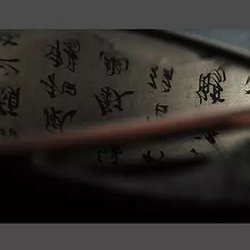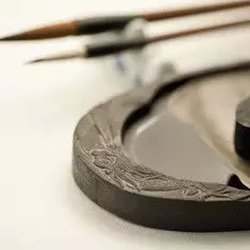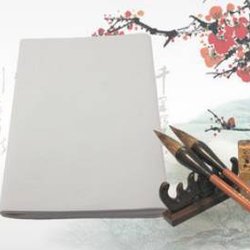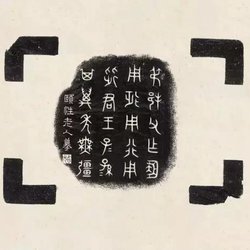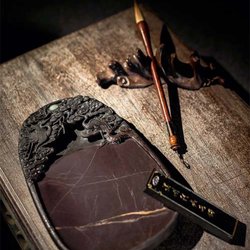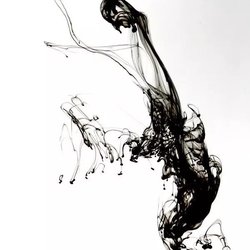It is said that the writing brush was invented by Meng Tian, a general of the Qin State. Some people also say that "Yu Shun made pens".
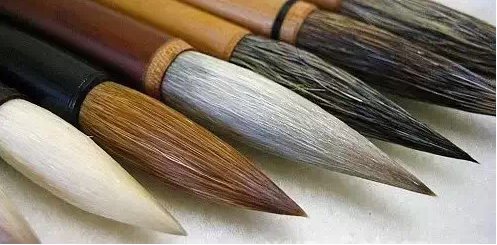
In fact, the history of the writing brush is much earlier than that of Meng Tian and Yu Shun. On the Yangshao painted pottery of primitive culture, there are patterns drawn with brushes. Wherever the edges are exposed, the traces of each brush hair are clearly visible. Its history is older than writing, at least 6,000 years ago.
The reason why Chinese calligraphy has become an art and is famous all over the world has a lot to do with the use of a special writing instrument such as a brush. The tip of the brush is made of the beard hair of sheep, wolves, rats, rabbits, etc. Because it is soft and can be light or heavy, thick or thin, it is possible to write wonderful and unique point paintings, forming a superb artistic realm. Brushes and tools made of other materials can also write various beautiful fonts, but it is difficult to achieve such high artistic achievements as brush calligraphy.
There are thousands of years of experience in making brushes, and the most famous one is Hu brush. Hubi is named after it was produced in ancient Huzhou. It was founded in the Yuan Dynasty and has a history of more than 700 years.
There are soft brushes, hard brushes and both brushes.
Ruanhao: soft in nature and easy to soak in ink; wool is mostly used as raw material, so it is commonly called sheep hair. Some calligraphers believe that it is easy to develop writing skills with wool brushes, and suggest that beginners should use sheep brush brushes. My experience is that when primary and secondary school students learn calligraphy, they usually start with Chinese regular script and should focus on neatness first. Although Yanghao is good, it is difficult to master, so it is more appropriate to use Jianhao.
Hard hair: Strong in nature and cannot contain too much ink; it is mainly made from weasel tail hair, so it is commonly called wolf hair. When practicing small characters, for the sake of neatness, it is better to use hard pen.
Jianhao: It is neutral, hard and soft at the same time. It is made of sheep hair and other animal hair. The color of the hare's fur is close to purple, so the hare is also called purple hair. According to the proportion, if there are seven purple and three sheep, three sheep and seven purple, five sheep and five purple, it is called both purple and sheep.
How to choose a pen?
First, the size and softness should be practical. Generally speaking, use a large pen and soft pen to write big characters; use a small pen and hard pen to write small characters.
Second, the pen tip should be as round as a cone and as sharp as a chisel, with the four characteristics of round, pointed, neat, and strong. Round means that the tip of the pen is round and full; point means that the tip of the pen is as sharp as a cone; Qi means that the tip of the pen is smoothed and flattened, so that the tip is as flat as a chisel; Jian means that the tip of the pen is elastic and strong. You can dip the new pen in some saliva to moisten it, and circle it back and forth on your thumb nail. If it can rotate freely, then lift it up and the pen tip will naturally tighten and return to a straight point, that's it.
How to care for your pen?
When a new pen is used, there is glue on the tip of the pen. It must be soaked in warm water (not hot water) and allowed to develop, which is called a hair pen. Be careful not to twist it hard, let alone bite it open with your teeth. The small regular script pen can open 2/5 of the pen tip, the medium regular script pen can open 1/2, and the large regular script pen can open 2/3. Generally speaking, it is not advisable to use the full hair of the brush, otherwise it will be weak and weak. The appropriate amount of development ultimately depends on whether it is suitable for use.
After using the brush, the large-character pen should be washed with clean water so that no ink remains, and then the pen tip should be straightened out, with the pen tip facing down, and hung up. Small pens should be protected with pen covers to prevent them from clumping. If it is not used for a long time, it should be placed in a box or bag with camphor to prevent insects.

